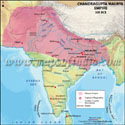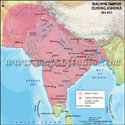Though his conquests had been spectacular, Alexander never conquered India. Not even Punjab and Indus valley completely came under his possessions. Alexander died in 323BCE but before his death he deployed his troops west of Indus. This invasion had completely changed the history of India.
A young man in Taxila thought that what a European could do, an Indian could do far better and began to train an army. This man took over the control of Magadha. He was none other than Chandragupta Maurya. This is where the Mauryan Empire began to develop.
The great Brahman teacher, Kautilya was Chandragupta's 'guru'. Once when he invaded Punjab he was lucky enough to be able to conquer the Nanda throne. He got his much needed chance when the successors of Alexander tried to subdue the eastern leaders who united against him; this is when he captured Taxila.
When the situation stabilized a little in the former kingdom of Alexander, on of his successor offered a peace treaty to Chandragupta. But when he recognized the Mauryan Empire he gave up the eastern territories which led to 'epigamic rule' (which means two dynasties intermarried).
By now the Indus and Ganges valley had been united by Chandragupta. Great services were seen at that time and the capital Patna was turned into a very beautiful city. This was when Kautilya, Chandragupta's teacher wrote 'Arthashastra', a guide to statecraft.
Chandragupta wasn't that deeply into Brahmanism. As the Jainist scriptures suggest Chandragupta converted to Jainism before death in favor of his to be successor and son, Bindusara.
Bindusara Maurya was Chandragupta's son and the lawful successor of the Mauryan dynasty. His rule lasted till 297BCE. He is the least popular out the three Mauryan rulers. It is said that he is the man who conquered the country between two seas (which means central India).
Ashoka succeeded his father in 272BCE and proved to a great conqueror. Except for the south India he united the Indian subcontinent. After the massacre and bloodshed in Kalinga war the king converted to Buddhism. After the conversion Ashoka was very keen on 'ahinsa' (non violence). South India and Sri Lanka could never be conquered by him because he rather went out on missionaries for converting others to religious beliefs. Several 'stupas' were constructed by him and slaughter of animals was forbidden.
It was after the death of Ashoka that the Mauryan Empire began to decline. Greek descendants in 240BCE came in and began invading and conquering the Mauryan Empire sites. In 184BCE Greek culture began to flourish in the south of the Hindu-Kush range. When Demetrius, the Greek ruler died his sons looked after the kingdom and kept fighting against the already shrunken Mauryan Empire. Later they even captured Patna which was the capital of the Mauryan kingdom.
Last Updated on: November 13, 2025







